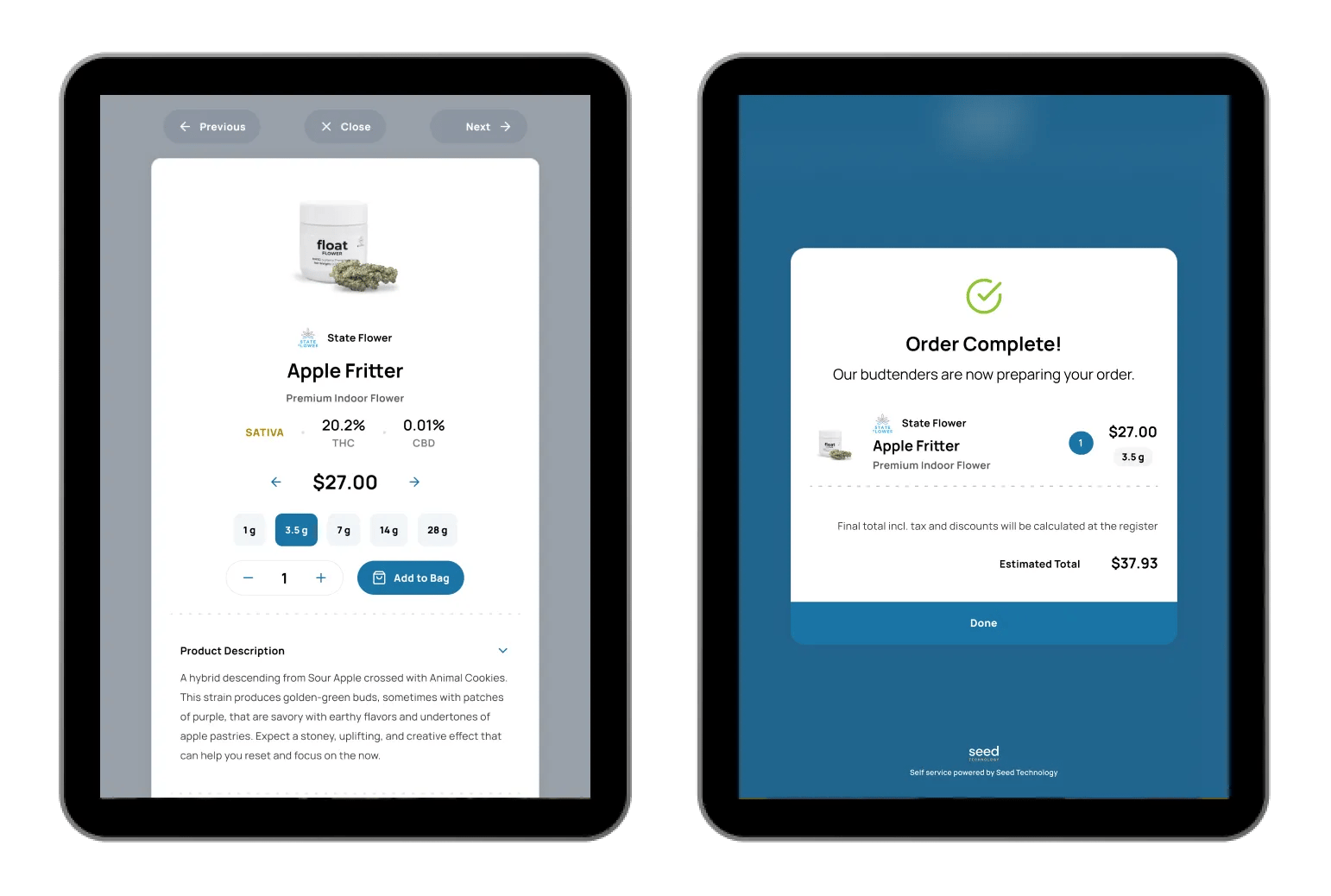Everyone has an understanding of the term “self service,” being common in banking, retail, supermarkets, and more.
But what about its place in cannabis dispensaries?
In this post, we'll explore what cannabis self-service means, including the benefits and risks of incorporating self-order kiosks, and how to determine if it’s right for your dispensary.
The definition of cannabis self service
Cannabis self-service, or self-ordering, allows customers to browse products and place orders without the need for human interaction.
This technology can take many forms, including interactive kiosks, vending machines, and apps. But most common to the in-store dispensary experience is interactive touchscreens or tablets positioned strategically within the waiting room or on the sales floor. Kiosks are often mounted on the wall, or on a tabletop or floor stand.
Cannabis self-service kiosks are designed to provide customers with a more convenient, efficient, and personalized shopping experience.

The primary difference in cannabis dispensary compared to your local grocery store is the actual checkout process. Self-ordering is really a better way to describe this technology, because of strict compliance procedures in cannabis.
- Shoppers can't gather and scan their own products. Instead, dispensary customers identify what they want to purchase. Once they submit their order, dispensary staff fulfill the order, just as they would a typical transaction.
- Shoppers can't complete the transaction. Customers at dispensaries need to interact with budtenders to complete the transaction, including providing ID, paying, and actually receiving their cannabis products.
- Shoppers can't browse the store at will. Some states require 1:1 budtender assistance; some require waiting rooms, and some don't allow the use of kiosks. This means self-ordering technology must first be allowed, and then must be a careful addition to your store layout. Shoppers at supermarkets know to use the tech (and how) — your customers will need more guidance and suggestion.
Now that we've covered what self-service means for cannabis dispensaries, and how it differs from self-service in our daily lives, read on for some of the benefits and risks of using self-order kiosks in your dispensary.
Benefits of self order kiosks
The main benefit is cannabis self-service kiosks allow customers to interact with a dispensary's up-to-date product list without the need for human interaction. And this has an impact on several areas of operation:
- Improved efficiency: Self-service can help dispensaries streamline operations by speeding up transactions. Called throughput, this means you can see the same (or more) customers without increasing hours or headcount.
- Convenience: Self-service provides customers with the convenience of browsing products and placing orders at their own pace. Savvy consumers want options in how they buy: self-ordering for those who want it, helpful budtenders for those who don’t.
- Personalization: Self-service dispensary kiosks can help provide a more personalized shopping experience. Customers and patients can take a quiz to see specific products they may enjoy. They can also see applicable deals to help them feel confident in their chosen cannabis products.
- Increased sales: Self-service can increase sales in two ways: 1) by creating an amazing checkout experience, which leads to increased satisfaction and loyalty, and 2) integrated upsell opportunities within your self-ordering solution are proven to increase average order size, resulting in more profits.

Risks of incorporating cannabis self service
There’s more potential upside than risks with dispensary self-ordering kiosks, but there are a few things to consider:
- Compliance: Dispensaries must ensure that their self-service process is in compliance with regulations. For example, some states require one-on-one budtender support while in the bud room. You could still use self-service, where staff assists the customer through the experience, but it may not have as much of an impact on store throughput.
- Management: Just like with any technology — POS, printers, security system, etc. — you will need a dedicated person to manage the software, troubleshoot in the rare event of an issue, and regularly update your kiosk attract screens and menu layouts.
- Customer satisfaction: This benefit is also a risk. If you lean too heavily into self-ordering, some of your customers may go elsewhere. We’ve seen this in stores like Walmart, where customers are unhappy about being required to self-serve (rather than having it be a choice of preference or convenience).
- Adoption: Integrating a new process into your store isn’t always smooth. You’ll need to educate everyone. Staff need to know how the kiosks work, and how to support shoppers with questions. You’ll also have to encourage people to use them. Place a tablet in a corner without clear signage or instruction won’t change behavior, and thus won’t provide the business impact you’re looking for.
Tips for implementing self service
We think self-service is great for businesses and shoppers alike. It’s only a matter of time until self-ordering at dispensaries is commonplace.
But successful implementation of self service dispensary kiosks takes work.
Understand your goals.
If you know exactly what you hope to achieve with dispensary self-ordering kiosks, you can appropriately track and prove ROI. Examples include reducing staffing costs, speeding up average transaction time, increasing throughput/decreasing average wait time, increasing sales of house brands (or other featured products), or increasing average order value.
Find a cannabis self service partner who can help you achieve your goals.
Focus on overall cost (software + hardware), how well they will support you, and the user-friendliness of the actual technology. Some tech providers in the cannabis industry claim to offer kiosks, but it’s just a website on a tablet, which isn’t a great user experience (and won’t help you achieve your goals).
Prepare for a successful launch.
Again, you won’t achieve your retail goals if you don’t launch and encourage the use of the tool. Especially if this is a change to your store layout, customers won’t know it exists unless you show them.
The self-service flow needs to be strategically woven into your store operations to be successful, and staff will need to be bought in or you won’t get adoption. Think about airports; one airline staffer directs fliers toward the check-in stations, then supports them while they’re there, reducing the number of people in the main line. What started as a suggestion is now the standard.
The short version
Cannabis self-service is technology that allows customers to browse products and place orders on their own at a dispensary.
Incorporating cannabis self-service technologies can provide many benefits, including improved efficiency, convenience, personalization, and increased sales.
However, dispensaries must also be aware of the risks associated with these technologies, and how to successfully incorporate self-order kiosks.